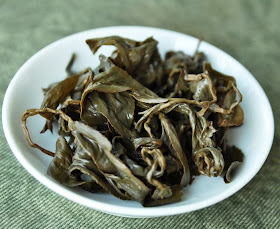Tuesday, September 17, 2013
Hung Shui Oolong transformation
Cultivar: Qingxin (luanze) Oolong
Origin: Alishan
Harvested by hand in spring 2000.
Process: light oxidation and light-medium roast at production
Storage: not vacuum bagged, it was kept in a plastic inside a big metallic cylindrical box. I found this tea in a local grocery store! The merchant doesn't actively promote his teas anymore. However, since I was curious about his old tea boxes, he showed me some Oolongs he has kept for over 10 years.
I like the fact that he doesn't re-roast his Oolongs like most tea merchants do. Such tea gives us a good glimpse to how Oolong can age naturally when kept at home by a tea fan (since most of us don't have a roaster or roasting skills). All too often, tea merchants over-roast their unsold inventories and end up killing the freshness in the leaves.
For this first test, I'm using 3 grams of leaves and brewed the tea for 6 minutes in my white gaiwan. Since the tea is old, it's best to use a strong pour.
1. View.
The dry Oolong leaves were tightly rolled, and have started to unfurl with age. This is consistent with old Hung Shui Oolong. The color is somewhere between the dark 1990 San Hsia Hung Shui Oolong and a greener recent one. With this tea, the roast is on the lighter side, because it's a high mountain Oolong. The leaves open up pretty well even after the first brew.
This brew has a good clarity and dark orange color.
2. Smells
The dry leaves completely lack roasting smells. Instead, we have a very ripe, fruity and malty smell. The brew smells very similar. It's like small wild strawberries and raspberries without their fresh astringency. These fragrances are unlike any you can find in young Oolongs, fresh or roasted. They remind me the 1990 San Hsia Hung Shui Oolong. These darker and heavier notes are secondary scents that only appear with the slow passing of time.
3. Taste
When pushed to its limits, this old tea displays some bitterness that slowly fades away. Overall, it's pretty mellow and has this nice balance of freshness and sweetness that we are looking for in old tea. In a second brew, the level of bitterness decreased and it felt sweeter. The 'green', fresh taste resurfaces more and more as the leaves release their aromas. The aftertaste is very long and subtle.
The leaves unfurl well and seem to become completely fresh again!
Now, we can also see a large number of nice tips, a sign of quality.
Conclusion: with this aged Hungshui Oolong, we can smell the wonderful transformation potential of young roasted Oolong. Patience and good leaves, well stored, can produce such wonderful aromas, combining the thick harmony of age without loosing their underlying freshness. These leaves provide a partial glimpse to such result. I say partial, because the taste could/should be less bitter to be really perfect. The very reasonable price of this tea reflects this small defect.
I believe that the best way to have excellent quality Hung Shui Oolong is to purchase it young and store it yourself in a good porcelain jar.
Top quality aged Dong Ding Oolong from the early 1980s can be worth as much as its weight in gold! And, each time I had the opportunity to try, such Oolong tasted like heaven for me. Very few of us will be able to afford such a price in 30 years. That's why I recommend that you plan ahead: select a good Hung Shui Oolong, preferably of a year that has meant something for you (graduation, wedding, kids...) and enjoy it never more than once a year! 300 grams could last over 40 years if you use 7 grams or less per session.
Don't forget: time flies!












No comments:
Post a Comment